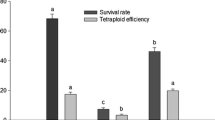Summary
Hybrids ofHordeum vulgare (HV) xH. jubatum (HJ) were synthesized for purposes of introgressive breeding, but were sterile and the recovery of pure diploid tillers by colchicine applications in vivo was difficult. Plant regeneration from colchicine-treated callus cultures of the hybrid (HV x HJ) was investigated as a means to produce high numbers of pure diploid, fertile intermediates. 10 of 50 plants regenerated in this manner exhibited variable chromosome numbers with means of approximately 37 (expected diploid number = 42). Cytological examinations of microsporogenesis in all such plants revealed a high incidence of bivalent formation at metaphase I (as compared to nearly complete asynapsis in the F1), but spindle and chromosome abnormalities in later meiotic stages led to complete sterility. Approximately 40% of HJ plants regenerated from colchicine-treated calli appeared to be pure tetraploids of high fertility. These techniques are hence useful for high frequency production of diploid or polyploid plants.
Similar content being viewed by others
Literature
Caldwell, R.M.; Schafer, J.F.; Compton, L.E.; & Patterson, F.L. (1965): Resistance to leaf rust derived fromAgropyron elongatum. Int. Wheat Rust Conf.3, 95–96
D'Amato, F. (1977): Cytogenetics of differentiation in tissue and cell cultures. In: Plant cell, tissue, and organ culture (eds.: Reinert, J.; Bajaj, Y.P.S.), pp. 343–357. Berlin-Heidelberg-New York: Springer
Darlington, CD.; Thomas, P.T. (1937): The breakdown of cell division in aFestuca-Lolium derivative. Ann. Bot.1, 747–761
Galinat, W.C. (1977): The origin of corn. In: Corn and corn improvement. (ed. Sprague, G.F.), pp. 1–48. Madison, Wis. Amer. Soc. Agron.
Gamborg, O.L.; Miller, R.A.; Qjima, K. (1968): Nutrient requirements of suspension cultures of soybean root cells. Exper. Cell Res.50, 148–151
Kasha, K.J. (1975): Haploids from somatic cells. In: Haploids in higher plants, advances and potential. (ed.; Kasha, K.J.), pp. 67–90. Guelph, Ont. (Canada): University of Guelph
Knott, D.R. (1961): The inheritance of rust resistance 6: The transfer of stem rust resistance fromAgropyron elongatum to common wheat. Can. J. Plant Sci.41, 109–123
Knott, D.R.; Dvorak, J.; Nanda, J.S. (1977): The transfer to wheat and homoeology of anAgropyron elongatum chromosome carrying resistance to stem rust. Can. J. Genet. Cytol.19, 75–79
Larson, R.I.; Atkinson, T.G. (1973): Wheat-Agropyron chromosome substitution lines as sources of resistance to wheat streak mosaic virus and its vector,Aceria tulipae. Proc. Int. Wheat Genet. Symp.4, 200–214
Linsmaier, E.M.; Skoog, F. (1965): Organic growth requirement of tobacco tissue cultures. Physiol. Plant.18, 100–127
Murashige, T.; Nakano, R. (1966): Tissue culture as a potential tool in obtaining polyploid plants. J. Hered.57, 115–118
Murry, L.E. (1975): A cytogenetic investigation of xAgrohordeum pilosilemma. E. Lansing, Mich.: Ph.D. Thesis, Michigan State University
Orton, T.J. (1979): A quantitative analysis of growth and regeneration from tissue cultures ofHordeum vulgare, H. jubatum, and their interspecific hybrid. Environm. Exper. Bot. (in press)
Orton, T.J. (1980): Chromosomal variability in tissue cultures and regenerated plants ofHordeum. Theor. Appl. Genet.56,
Rajathy, T.; Morrison, J.W. (1959): Cytogenetic studies in the genusHordeum 4: Hybrids ofH. jubatum, H. brachyantherum, H. vulgare, and a hexaploidHordeum sp. Can. J. Genet. Cytol.1, 124–132
Rick, C.M. (1973): Potential genetic resources in tomato species: clues from observations in native habitats. In: Genes, enzymes and populations. (ed.: Srb, A.M.), pp. 235–269. New York: Plenum Press
Sears, E.R. (1956): The transfer of leaf-rust resistance fromAegilops umbellulata to wheat. Brookhaven Symp. Biol.9, 1–22
Sears, E.R. (1972): Chromosome engineering in wheat. Stadler Symp.4, 23–38
Smith, H.H. (1971): Broadening the base of genetic variability in plants. J. Hered.62, 265–276
Starks, G.D.; Tai, W. (1974): Genome analysis ofHordeum jubatum andH. compressum. Can. J. Genet. Cytol.16, 663–668
Steidl, R.P. (1976): The hybridizations of barley (Hordeum vulgare L. Emend Lam.) with its wild relatives. E. Lansing, Mich.: Ph.D. Thesis, Michigan State University
Sunderland, N. (1977): Nuclear cytology. In Plant cell and tissue culture. Vol. 2, pp. 177–206. Berkeley, Calif.: University of California Press
Wagenaar, E.B. (1960): The cytology of three hybrids involvingHordeum jubatum L.: The chiasma distributions and the occurrence of pseudoring bivalents in genetically-induced asynapsis. Can. J. Bot.38, 69–85
Author information
Authors and Affiliations
Additional information
Communicated by F. Mechelke
Rights and permissions
About this article
Cite this article
Orton, T.J., Steidl, R.P. Cytogenetic analysis of plants regenerated from colchicine-treated callus cultures of an interspecificHordeum hybrid. Theoret. Appl. Genetics 57, 89–95 (1980). https://doi.org/10.1007/BF00745037
Accepted:
Issue Date:
DOI: https://doi.org/10.1007/BF00745037




